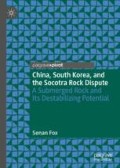Abstract
This chapter discusses present and future considerations surrounding the management and possible resolution of this dispute. It evaluates the possibility of a settlement, and the options open to the two parties, contending that shared or joint-use zones in such areas as fisheries and seabed resources, for example, may serve to reduce frictions while benefitting all the parties concerned. The case is also argued for South Korea revising its contradictory natural prolongation and continental shelf-based claim vis-à-vis Japan elsewhere in the East China Sea. In addition, technological advances in resource extraction, for example, will represent opportunities and challenges for friendlier ties in the future. The chapter asserts that present and future difficulties do not necessarily mean the two neighbors are on an inevitable path to confrontation over this submerged rock.
Access this chapter
Tax calculation will be finalised at checkout
Purchases are for personal use only
Notes
- 1.
For expert commentary and Chinese perspectives on the PRC ADIZ declaration, see Michael Swaine, ‘Chinese Views and Commentary on the East China Sea Air Defense Identification Zone (ECS ADIZ)’, China Leadership Monitor, Hoover Institution, Stanford University. 14/03/2014, no. 43: https://www.hoover.org/research/chinese-views-and-commentary-east-china-sea-air-defense-identification-zone.
- 2.
For a recent example of how the conservative right-wing in South Korea exploits heightened security-related tensions with China, see ‘Hong unveils security doctrine to drum up conservative support’, Yonhap News, 19/04/2017: http://english.yonhapnews.co.kr/news/2017/04/19/0200000000AEN20170419009751315.html.
- 3.
See Kristian McGuire, ‘China-South Korea Relations: A Delicate Détente’, The Diplomat (27/02/2018): https://thediplomat.com/2018/02/china-south-korea-relations-a-delicate-detente/.
- 4.
This is not to downplay China’s legitimate concerns over the potential strategic threat posed by the missile defense system. For more on why the PRC has protested the ROK’s THAAD system, see, ‘What is THAAD anti-missile defence system and why is China against it?’, 07/03/2017, Straits Times: https://www.straitstimes.com/asia/east-asia/what-is-thaad-anti-missile-defence-system-and-why-is-china-against-it; and Michael D. Swaine, ‘Chinese Views on South Korea’s Deployment of Terminal High Altitude Area Defense (THAAD)’, 14/02/2017, Chinese Leadership Monitor, no. 52, Hoover Institution, Stanford University: https://www.hoover.org/research/chinese-views-south-koreas-deployment-thaad.
- 5.
For enhanced relations between the ROK and the PRC, see Peter Murphy, ‘The Limits of the Japan–South Korea Military Relationship—Could Japan Lose South Korea to China?’, 21/09/2016, The Diplomat: https://thediplomat.com/2016/09/the-limits-of-the-japan-south-korea-military-relationship/.
- 6.
For more on a subsequent conference, see Do Je-hae, ‘“One Ocean Forum” proposed for maritime disputes in East Asia’, 28/09/2014, Korea Times: http://www.koreatimes.co.kr/www/news/nation/2014/09/359_165367.html.
- 7.
For examples, see Jeremy Bender, ‘Russia and China are drastically scaling up their presence in Antarctica’, 05/01/2016, Business Insider: http://www.businessinsider.com/russia-china-scaling-up-antarctic-presence-2015-12; Basia Rosenbaum, ‘The Battle for Arctic Oil’, 09/03/2015, Harvard International Review: http://hir.harvard.edu/article/?a=10586; Tim Daiss, ‘How Oil Drives the South China Sea Conflict’, 14/03/2018, OilPrice.com : https://oilprice.com/Energy/Energy-General/How-Oil-Drives-The-South-China-Sea-Conflict.html; Viola Zhou, Viola, ‘China’s deep-sea mission to mine the wealth beneath the ocean floor’, 06/10/2016, South China Morning Post: http://www.scmp.com/news/china/policies-politics/article/2025456/chinas-deep-sea-mission-mine-wealth-beneath-ocean-floor.
- 8.
For more on this China-Vietnam agreement see Benoit de Tréglodé, ‘Maritime Boundary Delimitation and Sino-Vietnamese Cooperation in the Gulf of Tonkin’, transl. David Buchanan, China Perspectives, 3 (2016): 33–41; Zou Keyuan, ‘The Sino-Vietnamese Agreement on Maritime Boundary Delimitation in the Gulf of Tonkin’, Ocean Development & International Law, 36, no. 1: 13–24.
- 9.
- 10.
See Wada, 2010.
Bibliography
Doi, Takateru and Hajimu Takeda. “Japan, S. Korea scramble jets to ward off Chinese military planes.” Asahi Shimbun, 30/01/2018. http://www.asahi.com/ajw/articles/AJ201801300046.html
Heo, Ho-joon. “American nuclear submarine enters Jeju Naval Base.” Hankyoreh, 24/11/2017. http://www.hani.co.kr/arti/english_edition/e_international/820635.html
Huang, Kristin. “Japan, South Korea scramble fighter jets after eight Chinese warplanes fly over Korea Strait.” South China Morning Post, 10/01/2017. http://www.scmp.com/news/china/diplomacy-defence/article/2060823/japan-and-south-korea-scramble-fighter-jets-8-chinese
Kim, Sarah and Lee Chul-jae. “Chinese planes penetrate Korea’s ADIZ.” Korea JoongAng Daily, 11/01/2017. http://koreajoongangdaily.joins.com/news/article/article.aspx?aid=3028512
Kim, Young-jin. “Why Ieodo matters.” Korea Times, 18/09/2012. http://www.koreatimes.co.kr/www/news/nation/2012/09/117_120266.html
Law, Violet. “China’s Liaoning aircraft carrier conducts first live-fire drill as Beijing shows off military might.” South China Morning Post, 16/12/2016. http://www.scmp.com/news/china/diplomacy-defence/article/2055138/chinas-liaoning-aircraft-carrier-conducts-first-live
Lotto, Sofia Persio. “Chinese Warplanes Enter Korea Air Defense Zone, Prompting South Korea to Scramble Fighter Jets,” Newsweek, 18/12/2017. http://www.newsweek.com/chinese-warplanes-enter-korea-air-defense-zone-south-korea-scramble-fighter-750918
Panda, Ankit. “Chinese Fighter Violates South Korea’s Air Defense Identification Zone.” The Diplomat, 28/02/2018. https://thediplomat.com/2018/02/chinese-fighter-violates-south-koreas-air-defense-identification-zone/
Park, Yuna and Hyunjoo Jin. “S.Korea seizes 2nd ship suspected of providing oil to N.Korea.” Reuters, 31/12/2017. https://www.reuters.com/article/us-northkorea-missiles-southkorea-ship/south-koreaseizes-second-ship-suspected-of-providing-oil-to-north-korea-idUSKBN1EP04P
S. Korean Navy seeks aviation command, new task fleet (19/10/2017), Yonhap News. http://english.yonhapnews.co.kr/northkorea/2017/10/19/98/0401000000AEN20171019004652315F.html
Van Dyke, Jon M. “Ieodo.” Maritime Boundary Disputes in the East China Sea (conference), Seoul, South Korea, 30/06/2011–01/07/2011.
Wada, Haruki. “Resolving the China-Japan Conflict Over the Senkaku/Diaoyu Islands.” History News Network, 31/10/2010. http://www.hnn.us/articles/133059.html
Author information
Authors and Affiliations
Rights and permissions
Copyright information
© 2019 The Author(s)
About this chapter
Cite this chapter
Fox, S. (2019). Present and Future Considerations. In: China, South Korea, and the Socotra Rock Dispute. Palgrave Pivot, Singapore. https://doi.org/10.1007/978-981-13-2077-4_7
Download citation
DOI: https://doi.org/10.1007/978-981-13-2077-4_7
Published:
Publisher Name: Palgrave Pivot, Singapore
Print ISBN: 978-981-13-2076-7
Online ISBN: 978-981-13-2077-4
eBook Packages: Political Science and International StudiesPolitical Science and International Studies (R0)

